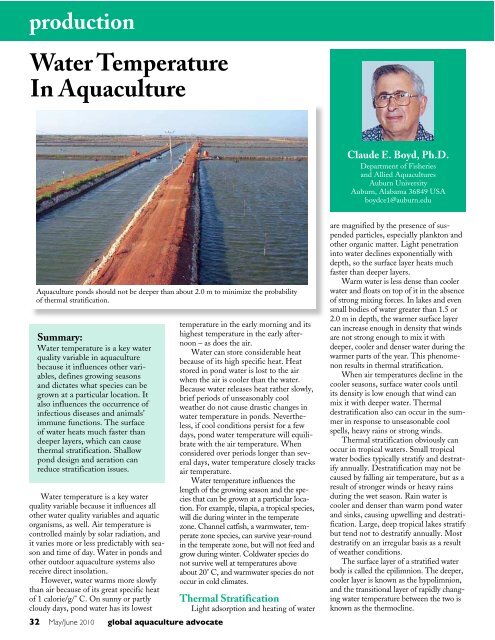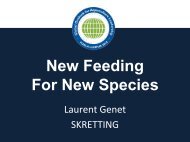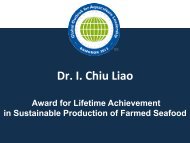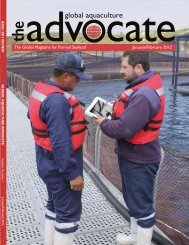May/June 2010 - Global Aquaculture Alliance
May/June 2010 - Global Aquaculture Alliance
May/June 2010 - Global Aquaculture Alliance
Create successful ePaper yourself
Turn your PDF publications into a flip-book with our unique Google optimized e-Paper software.
production<br />
Water Temperature<br />
In <strong>Aquaculture</strong><br />
<strong>Aquaculture</strong> ponds should not be deeper than about 2.0 m to minimize the probability<br />
of thermal stratification.<br />
Summary:<br />
Water temperature is a key water<br />
quality variable in aquaculture<br />
because it influences other variables,<br />
defines growing seasons<br />
and dictates what species can be<br />
grown at a particular location. It<br />
also influences the occurrence of<br />
infectious diseases and animals’<br />
immune functions. The surface<br />
of water heats much faster than<br />
deeper layers, which can cause<br />
thermal stratification. Shallow<br />
pond design and aeration can<br />
reduce stratification issues.<br />
Water temperature is a key water<br />
quality variable because it influences all<br />
other water quality variables and aquatic<br />
organisms, as well. Air temperature is<br />
controlled mainly by solar radiation, and<br />
it varies more or less predictably with season<br />
and time of day. Water in ponds and<br />
other outdoor aquaculture systems also<br />
receive direct insolation.<br />
However, water warms more slowly<br />
than air because of its great specific heat<br />
of 1 calorie/g/° C. On sunny or partly<br />
cloudy days, pond water has its lowest<br />
temperature in the early morning and its<br />
highest temperature in the early afternoon<br />
– as does the air.<br />
Water can store considerable heat<br />
because of its high specific heat. Heat<br />
stored in pond water is lost to the air<br />
when the air is cooler than the water.<br />
Because water releases heat rather slowly,<br />
brief periods of unseasonably cool<br />
weather do not cause drastic changes in<br />
water temperature in ponds. Nevertheless,<br />
if cool conditions persist for a few<br />
days, pond water temperature will equilibrate<br />
with the air temperature. When<br />
considered over periods longer than several<br />
days, water temperature closely tracks<br />
air temperature.<br />
Water temperature influences the<br />
length of the growing season and the species<br />
that can be grown at a particular location.<br />
For example, tilapia, a tropical species,<br />
will die during winter in the temperate<br />
zone. Channel catfish, a warmwater, temperate<br />
zone species, can survive year-round<br />
in the temperate zone, but will not feed and<br />
grow during winter. Coldwater species do<br />
not survive well at temperatures above<br />
about 20° C, and warmwater species do not<br />
occur in cold climates.<br />
Thermal Stratification<br />
Light adsorption and heating of water<br />
Claude E. Boyd, Ph.D.<br />
Department of Fisheries<br />
and Allied <strong>Aquaculture</strong>s<br />
Auburn University<br />
Auburn, Alabama 36849 USA<br />
boydce1@auburn.edu<br />
are magnified by the presence of suspended<br />
particles, especially plankton and<br />
other organic matter. Light penetration<br />
into water declines exponentially with<br />
depth, so the surface layer heats much<br />
faster than deeper layers.<br />
Warm water is less dense than cooler<br />
water and floats on top of it in the absence<br />
of strong mixing forces. In lakes and even<br />
small bodies of water greater than 1.5 or<br />
2.0 m in depth, the warmer surface layer<br />
can increase enough in density that winds<br />
are not strong enough to mix it with<br />
deeper, cooler and denser water during the<br />
warmer parts of the year. This phenomenon<br />
results in thermal stratification.<br />
When air temperatures decline in the<br />
cooler seasons, surface water cools until<br />
its density is low enough that wind can<br />
mix it with deeper water. Thermal<br />
destratification also can occur in the summer<br />
in response to unseasonable cool<br />
spells, heavy rains or strong winds.<br />
Thermal stratification obviously can<br />
occur in tropical waters. Small tropical<br />
water bodies typically stratify and destratify<br />
annually. Destratification may not be<br />
caused by falling air temperature, but as a<br />
result of stronger winds or heavy rains<br />
during the wet season. Rain water is<br />
cooler and denser than warm pond water<br />
and sinks, causing upwelling and destratification.<br />
Large, deep tropical lakes stratify<br />
but tend not to destratify annually. Most<br />
destratify on an irregular basis as a result<br />
of weather conditions.<br />
The surface layer of a stratified water<br />
body is called the epilimnion. The deeper,<br />
cooler layer is known as the hypolimnion,<br />
and the transitional layer of rapidly changing<br />
water temperature between the two is<br />
known as the thermocline.<br />
Epilimnion<br />
Wind-Driven Water Circulation Uniformly<br />
Warm Water<br />
Thermocline<br />
Hypolimnion<br />
Because warm water is less dense than cold, it floats on top until mixed into the underlying<br />
transitional layer by wind or other mechanical means. In deep ponds, the mixing<br />
process is limited.<br />
Water Quality Deterioration<br />
Because the hypolimnion does not<br />
receive enough light for photosynthesis,<br />
and organic particles settle into it, its<br />
water quality often becomes impaired by<br />
dissolved oxygen depletion and high concentrations<br />
of organic matter and other<br />
reduced substances during stratification.<br />
Sudden destratification mixes epilimnetic<br />
water with hypolimnetic water, which can<br />
result in water quality deterioration<br />
throughout the water column and mortality<br />
of culture animals.<br />
Destratification of lakes containing<br />
cage culture operations can be especially<br />
disastrous. Low dissolved-oxygen concentrations<br />
following sudden destratification<br />
have caused complete mortality of<br />
fish in cages. The likelihood of sudden<br />
destratification and its possible consequences<br />
on culture should be carefully<br />
assessed in selecting sites for cage farms.<br />
Aeration Mixing<br />
<strong>Aquaculture</strong> ponds should not be<br />
deeper than 2.0 m to minimize the probability<br />
of thermal stratification. Shallow<br />
ponds may stratify during the day, but<br />
destratification will break up at night.<br />
Ponds also should be oriented with their<br />
long axes parallel to the prevailing winds<br />
to encourage wind mixing.<br />
Mechanical aeration mixes ponds, but<br />
surface aeration may not prevent stratification<br />
of deep ponds. Two mechanical<br />
methods are available for avoiding<br />
destratification in small, deep water bodies.<br />
Vertical, axial-flow devices can be<br />
used to propel surface water downward to<br />
blend with deeper water and prevent layers<br />
of different densities from developing.<br />
Air diffusers placed in deep water induce<br />
upwelling and also prevent stratification.<br />
Seasonality<br />
Temperature has a pronounced effect<br />
on chemical reaction rates, the ability of<br />
water to hold dissolved oxygen and other<br />
gases, and growth and other physiological<br />
processes. According to Van Hoff’s law, a<br />
10° C increase in temperature will<br />
roughly double the rate of chemical reactions,<br />
including physiological processes<br />
and growth. The actual factor of increase<br />
How Do You Feed A Family Of Thousands - Millions?<br />
From the time they’re PL-5 to<br />
harvest, a Rangen quality shrimp<br />
diet is a must! Rest assured that<br />
you will see size and weight gain<br />
from the start. And with Rangen,<br />
you know they will produce a diet<br />
to your exact specifications. Every<br />
Rapidly Decreasing<br />
Water Temperature<br />
Rangen quality Shrimp Diet is<br />
formulated to get immediate<br />
results. Yes, Rangen makes it easy<br />
to feed your family of millions from<br />
the early stages to adult with a<br />
results driven diet for you.<br />
Call Us Today!<br />
32 <strong>May</strong>/<strong>June</strong> <strong>2010</strong> global aquaculture advocate global aquaculture advocate <strong>May</strong>/<strong>June</strong> <strong>2010</strong> 33<br />
Uniformly<br />
Cold Water<br />
wind<br />
0<br />
1<br />
2<br />
3<br />
4<br />
Depth (m)<br />
TM <strong>Aquaculture</strong><br />
Feeds Division<br />
www.rangen.com<br />
(800) 657-6446 Idaho (800) 272-6436 Texas<br />
(208) 543-4698 Fax (979) 849-6943 Fax





